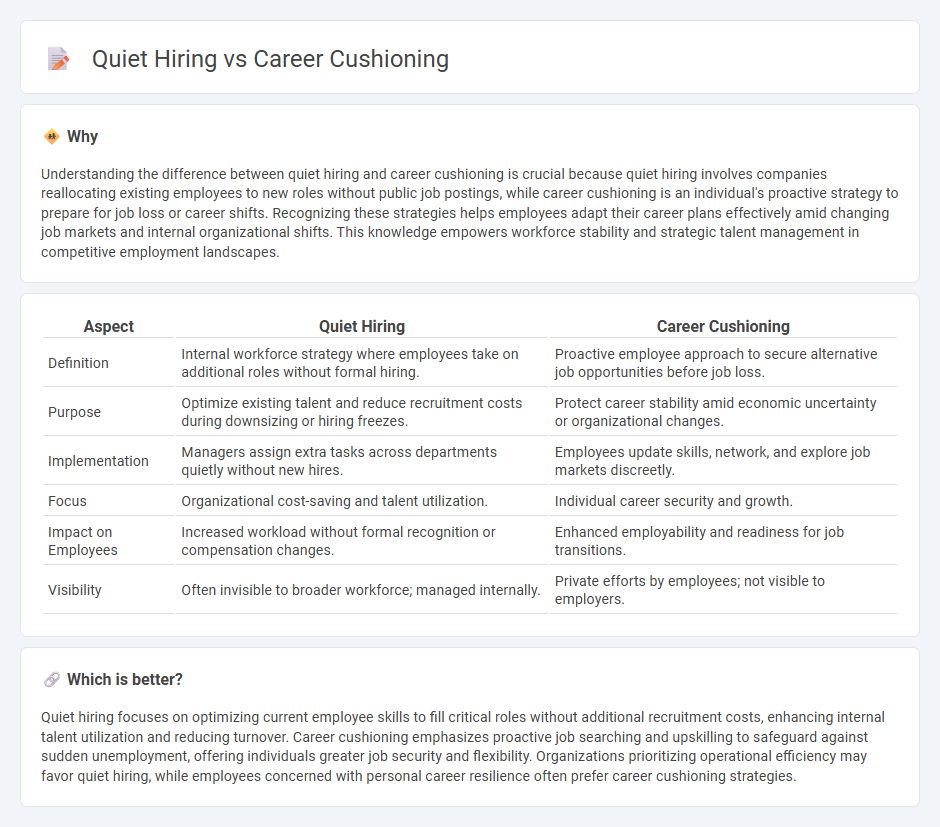
Quiet hiring involves organizations reallocating existing employees to fill new roles without public job postings, enhancing operational flexibility and talent utilization. Career cushioning refers to individuals proactively building additional skills and networks to safeguard against future job loss or career stagnation. Explore these strategies further to understand how they shape modern employment dynamics.
Why it is important
Understanding the difference between quiet hiring and career cushioning is crucial because quiet hiring involves companies reallocating existing employees to new roles without public job postings, while career cushioning is an individual's proactive strategy to prepare for job loss or career shifts. Recognizing these strategies helps employees adapt their career plans effectively amid changing job markets and internal organizational shifts. This knowledge empowers workforce stability and strategic talent management in competitive employment landscapes.
Comparison Table
| Aspect | Quiet Hiring | Career Cushioning |
|---|---|---|
| Definition | Internal workforce strategy where employees take on additional roles without formal hiring. | Proactive employee approach to secure alternative job opportunities before job loss. |
| Purpose | Optimize existing talent and reduce recruitment costs during downsizing or hiring freezes. | Protect career stability amid economic uncertainty or organizational changes. |
| Implementation | Managers assign extra tasks across departments quietly without new hires. | Employees update skills, network, and explore job markets discreetly. |
| Focus | Organizational cost-saving and talent utilization. | Individual career security and growth. |
| Impact on Employees | Increased workload without formal recognition or compensation changes. | Enhanced employability and readiness for job transitions. |
| Visibility | Often invisible to broader workforce; managed internally. | Private efforts by employees; not visible to employers. |
Which is better?
Quiet hiring focuses on optimizing current employee skills to fill critical roles without additional recruitment costs, enhancing internal talent utilization and reducing turnover. Career cushioning emphasizes proactive job searching and upskilling to safeguard against sudden unemployment, offering individuals greater job security and flexibility. Organizations prioritizing operational efficiency may favor quiet hiring, while employees concerned with personal career resilience often prefer career cushioning strategies.
Connection
Quiet hiring enables companies to fill skill gaps by internally redeploying employees without external recruitment, which supports career cushioning as workers develop versatile skills to safeguard against job instability. This strategy enhances workforce agility and employee marketability, allowing both employers and employees to adapt to shifting economic conditions. The symbiotic relationship between quiet hiring and career cushioning promotes sustainable employment growth and talent retention.
Key Terms
Job Security
Career cushioning involves proactively enhancing skills and networking to secure future job opportunities, while quiet hiring subtly reallocates existing staff to new roles without public announcements, both strategies aim to improve job security amid economic uncertainties. Career cushioning empowers employees to stay competitive, whereas quiet hiring allows companies to retain talent discreetly without layoffs. Explore more about how these approaches impact job security and career growth opportunities.
Talent Mobility
Career cushioning involves employees proactively developing new skills and exploring opportunities to secure their future job stability, whereas quiet hiring focuses on businesses internally reallocating existing talent to fulfill critical roles without formal external recruitment. Both strategies enhance talent mobility by maximizing workforce agility and promoting skill versatility within organizations. Discover more about how these approaches can transform talent management and strengthen organizational resilience.
Skill Development
Career cushioning involves building new skills and expanding professional networks to prepare for potential job transitions, emphasizing proactive personal growth. Quiet hiring, in contrast, leverages internal talent development by assigning employees new projects or roles to optimize workforce capabilities without external recruitment. Explore how skill development strategies differ between career cushioning and quiet hiring to enhance your professional advancement.
Source and External Links
What is Career Cushioning and How Can it Impact Business? - Indeed - Career cushioning is when employees keep other career options open by building networks, upskilling, or having side gigs to prepare for job uncertainty and protect their careers in unpredictable markets.
The importance of career cushioning in today's job market - Career cushioning acts as an insurance policy in volatile job markets, involving upskilling, side hustles, or moving to stable companies to prepare alternative rewarding career paths.
What Is Career Cushioning and Can It Lead to Success? - BetterUp - Career cushioning is developing a backup career plan through actions like job hunting, freelancing, or skill-building to mitigate risks of career disruptions, with pros including faster job transitions and cons like possible distraction from current roles.
 dowidth.com
dowidth.com